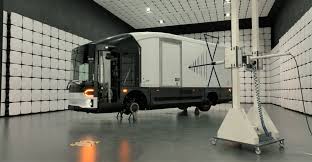Electromagnetic Compatibility (EMC) testing is an essential process that ensures electronic devices operate as intended without causing or being affected by electromagnetic interference. The growing demand for electronics across various industries—automotive, healthcare, telecommunications, and consumer electronics—requires reliable EMC testing to guarantee product safety and compliance. In this article, we will delve deep into what an EMC testing lab offers and why EMC testing is critical to product development.
What is EMC Testing?
Electromagnetic Compatibility (EMC) testing refers to the process of evaluating electronic devices to ensure they function properly in their electromagnetic environment. EMC testing measures how well a device can withstand interference from external sources and how much electromagnetic disturbance it emits.
Devices that fail EMC testing risk malfunctioning in the presence of other electronics, causing significant problems in sectors where safety and reliability are paramount, such as medical equipment or automotive components.
Why is EMC Testing Important?
EMC testing is not just a regulatory requirement but also a key factor in product development and market success. A product that passes EMC tests ensures that:
- It will not interfere with other devices.
- It will function correctly even when exposed to external electromagnetic interference.
- It meets regulatory standards, allowing it to be sold in various markets.
Regulatory agencies like the Federal Communications Commission (FCC) in the U.S. or the CE marking in Europe mandate that electronic products undergo EMC testing to ensure compliance.
What Does an EMC Testing Lab Do?
An EMC testing lab provides comprehensive testing services to ensure that devices meet both international and local regulatory requirements. Testing labs are equipped with specialized equipment to simulate various electromagnetic environments. Here’s what a typical EMC testing lab offers:
1. Emissions Testing
Emissions testing measures the amount of electromagnetic energy that a device emits. High emissions could interfere with nearby devices, which is why regulatory bodies set strict limits on allowable emissions levels. EMC testing labs use radiofrequency (RF) chambers to evaluate the radiated and conducted emissions of a device.
2. Immunity Testing
Immunity testing assesses how well a device can resist external electromagnetic interference. This is crucial in industries such as automotive or medical devices, where a malfunction could lead to life-threatening consequences. Testing labs simulate various electromagnetic disturbances to evaluate the product’s immunity.
3. Conducted Emissions Testing
Conducted emissions testing evaluates the electromagnetic disturbances emitted through power lines or other conductive elements. Devices are tested to ensure they don’t exceed specific thresholds that could interfere with the power grid or other connected devices.
4. Radiated Emissions Testing
This test evaluates electromagnetic energy that radiates from a device and ensures that the energy levels are within regulatory limits. High levels of radiated emissions can cause interference with nearby wireless devices and telecommunications systems.
5. Electrostatic Discharge (ESD) Testing
ESD testing is designed to simulate what happens when a device comes into contact with static electricity. This type of test is critical for consumer electronics, as static discharges can damage sensitive components.
6. Harmonics and Flicker Testing
For products designed to be connected to the public power supply, harmonics and flicker testing ensures that they do not introduce distortion into the electrical network, potentially causing issues for other connected equipment.
Key Equipment Used in EMC Testing Labs
EMC testing labs use a variety of specialized equipment to conduct tests under controlled conditions. Some of the most important tools include:
- Anechoic Chambers: These chambers are lined with material that absorbs electromagnetic waves, providing a controlled environment to measure radiated emissions.
- Spectrum Analyzers: These devices are used to measure the frequency and amplitude of electromagnetic signals.
- Line Impedance Stabilization Networks (LISNs): LISNs are used to measure conducted emissions.
- ESD Simulators: Used to simulate electrostatic discharges and evaluate how a device responds.
How Long Does EMC Testing Take?
The duration of EMC testing depends on the complexity of the product and the specific tests required. For a simple product, EMC testing can be completed in a few days, whereas complex products might take several weeks. It’s essential to plan for EMC testing early in the development process to avoid delays in product launch.
Choosing the Right EMC Testing Lab
Selecting a reliable EMC testing lab is crucial to ensure your product meets regulatory standards. When choosing a lab, consider the following factors:
1. Accreditation
Make sure the lab is accredited by recognized bodies, such as the American Association for Laboratory Accreditation (A2LA) or the United Kingdom Accreditation Service (UKAS). Accreditation ensures that the lab follows stringent testing protocols.
2. Expertise
Different industries have varying EMC testing requirements. Select a lab with experience in your industry—whether it’s automotive, telecommunications, or medical devices.
3. Turnaround Time
Some testing labs offer expedited services for clients on tight timelines. If you’re under a deadline, inquire about the lab’s turnaround time for testing and reporting.
4. Customer Support
Comprehensive customer support is vital. Choose a lab that offers guidance throughout the testing process, from preparing your device for testing to interpreting the results and making necessary improvements.
EMC Testing for Different Industries
1. Automotive
The automotive industry requires rigorous EMC testing due to the increasing number of electronic systems in vehicles. EMC testing for automotive electronics ensures that in-car systems such as infotainment, navigation, and critical safety features like ABS or airbag sensors function without interference.
2. Medical Devices
For medical devices, EMC compliance is non-negotiable. Devices like pacemakers, ventilators, and infusion pumps must function without interference to prevent life-threatening situations. Regulatory bodies like the FDA in the U.S. impose strict EMC testing requirements for medical devices.
3. Consumer Electronics
With the rising use of wireless technologies, consumer electronics are increasingly susceptible to electromagnetic interference. EMC testing ensures that products like smartphones, laptops, and tablets function properly in environments filled with other electronic devices.
EMC Testing and Compliance: A Business Advantage
EMC testing does more than ensure compliance with regulatory bodies—it offers a business advantage. A product that passes EMC testing can be marketed with a CE mark in Europe, the FCC mark in the U.S., or similar compliance marks in other regions. These certifications provide a competitive edge and help increase customer trust.
Conclusion
Investing in a reputable EMC testing lab is crucial for the success of your product. By ensuring compliance with local and international standards, you mitigate the risk of product recalls, market entry delays, and costly fines. As technology evolves and becomes more integrated into every aspect of our lives, EMC testing will remain a critical component in the development of reliable and safe products.



